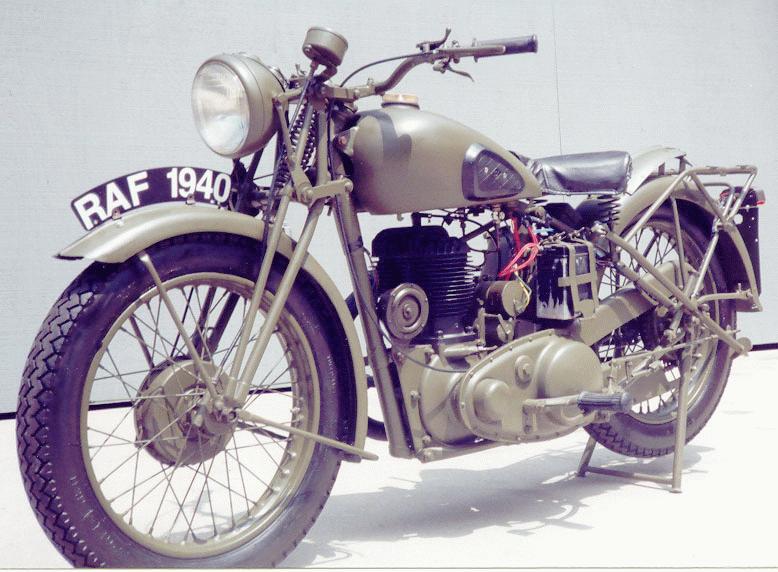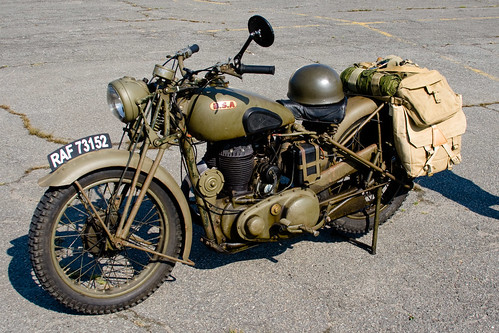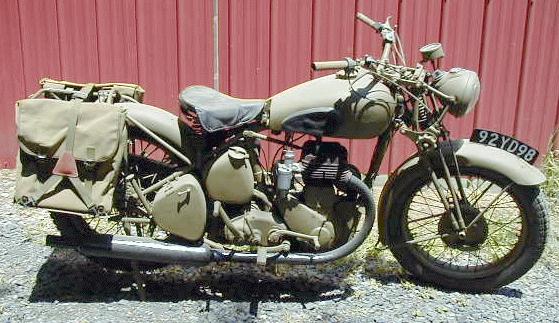(Continued from above)
The history of Triumph Motorcycles
From 1883 to 2003,
from Coventry to Meriden to Hinckley
http://www.ianchadwick.com/motorcycles/triumph/
http://www.ianchadwick.com/motorcycles/triumph/time02.html
1939
Tiger 90 discontinued. T100, with top speed of 95-100 mph, becomes a popular model in US. TT races put on hold again. Reggie Pink concentrates on Triumph sales. The Tiger 85 is announced, but never produced.
Edward Turner’s wife dies in a car crash near Coventry.
Freddie Clarke sets a new 350cc lap record at Brooklands, doing 105.97mph on a Tiger 80, then sets another doing 118.02mph on a bored-out 503cc T100. Val Page returns to Ariel. Sangster buys the bankrupt New Imperial name for use as a manufacturer of no-frills machines. But plans to resurrect the line are halted by the war, and never brought back.
World War II declared and within six weeks, 1,400 Triumph motorcycles are requisitioned from the factory for war use. This year, Reggie Pink, New York, offers all of Triumph’s 13 bike models in his shop.
1940
In January, the British government reduced production demands, allowing Triumph to manufacture bikes for the civilian and export markets again. In March, the French government contracts to buy 500cc side-valve bikes from Triumph. In May, the British government again requisitions bikes, halting civilian production. By July production for the military is up to 300 machines a week.
350cc side-valve vertical twin with rigid frame and girder forks (3TW based on Tiger 85 design) and 3HW (350cc ohv based on the Tiger 80; a “potentially great” bike, it offered a top speed of over 70 mph, weighed 240 lbs. and had a six inch ground clearance) singles approved for Services. Bert Hopwood believed the 3TW was a seriously flawed design. Fifty prototypes were made for testing, but destroyed in the Blitz. Hopwood wrote this was a “favour” to the War Office.
Priory Street works destroyed by German bombers on November 14 during blitz of Coventry. Initial batch of 50 350cc twins ready to go out are destroyed. This was the end of this model and motorcycles were never again built at this plant. The staff salvage all of the usable tools and parts from the rubble, only stopping when an unexploded bomb is found among the debris. The Blitz also destroyed all of Triumph’s technical records, drawings and designs. Production moved to temporary location in Warwick, while a new factory on the Birmingham-Coventry road outside Meriden is being built.
Sangster sells Ariel to BSA group. Canadian distributors Sammett & Blair (east) and Nicholson Brothers (west) selling Triumphs into US market, bringing much-needed foreign currency to Britain. Bruce “Boo Boo” Pearson wins 32 out of 36 competition events in California riding a Tiger 100. Johnson and Ceder move shop to Los Angeles, rename it Johnson Motors. Edward Turner visits Johnson Motors.
1941
Temporary premises acquired in Warwick and production restarts in June. 310 and 500cc side-valves in production by June for Services (advanced 3TW never built). Work on new factory at the village of Meriden started (reputed to be at the geographic centre of Britain). The company also built 6kW generators for RAF based on the Speed Twin engine, but using light alloy cylinder head and barrel. Called the AAPP (Airborne Auxiliary Power Plant), the design went on to become the basis of the post-war Grand Prix engine. Triumph also worked on a target-towing winch for the Navy.
Annie Bettmann dies. Triumph exports are cut off.
Turner’s “sprung hub” was supposed to go into production this year, adding 17 lbs to the weight of a bike. But the war delays introduction until 1948.
1942
New factory at Meriden in production mid-year for military, with single-cylinder 350cc ohv 3HW based on pre-war 3H (basically a Tiger 80 but without an air filter, which required major servicing every couple of thousand miles), but improved with enclosed valve gear, etc. Forty thousand built for military during war, out of a total of 49,700 motorcycles produced. Triumph also made aircraft components, track links, steering housings and two-wheeled stretcher carriers. Turner designs a generator using a Triumph vertical twin engine for the Air Ministry.
After a blazing row with Jack Sangster, Turner quit and moved to BSA as chief designer, where he worked on a side-valve vertical twin. Bert Hopwood becomes Triumph’s new designer and works on a new side-valve model to challenge Turner’s military machine for BSA.
1943
Bert Hopwood designs the 500cc, side-valve twin TRW model for the military, at the request of Jack Sangster (partly to challenge Turner at BSA who was working on a military 500cc twin), but it was never produced. prototypes were released in february, ahead of BSA’s planned launch. The design would become the post-war TRW model. In late October, Edward Turner returned to Triumph. Hopwood worked on design for an inline four-cylinder 700cc engine that could produce 50 bhp. Turner’s return to Triumph scuttled the plan.
1944
Edward Turner is Managing Director again. Alfred “Rich” Child, Harley-Davidson’s Asian sales agent, approaches Triumph to become their exclusive, factory-authorized importer into the USA. Turner and Sangster decide to stick with Johnson as their official distributor.
1945
During the war years, Triumph built 50,000 motorcycles. Large stock of used 3HW and 3SW (side-valve) models bought from War Department for reconditioning and repainting in new colours, sold in Britain for civilian use. In March, four twins and one single are announced, but the single and one twin never see production. The Speed Twin, Tiger 100 and 350cc 3T are made. They are fitted with telescopic forks (replacing the old girder front forks), but are otherwise the same as pre-war models. Turner designs the forks, but first models spew oil when bottoming out, so they are reworked by Freddie Clarke.
Johnson draws up plans for a US nation-wide dealer network and accepts applications for Ariel and triumph franchises. JoMo moves to a new location in Pasadena, investing $85,000 in renovations, including six hydraulic lifts in the service area. JoMo drops its Indian franchise, but picks up California-made Mustang, Lucas electrical products, Amal carbs, John Bull and Dunlop tires.
WW2 1942 Triumph 3HW 350cc video
http://www.youtube.com/watch?v=AvPRYpuz0ew
Triumph 3HW video
http://www.youtube.com/watch?v=NO4WuB5G6Jg
Image results for “Triumph 3HW”
http://images.google.com/images?hl=en&as_epq=Triumph+3HW&as_oq=&as_eq=&num=10&lr=&as_filetype=&as_sitesearch=&as_qdr=all&as_rights=&as_occt=any&cr=&as_nlo=&as_nhi=&safe=off&q=“Triumph+3HW”&um=1&ie=UTF-8&ei=XTMIS-_4G4OXtgfQnLy_Cg&sa=X&oi=image_result_group&ct=title&resnum=7&ved=0CCYQsAQwBg

























